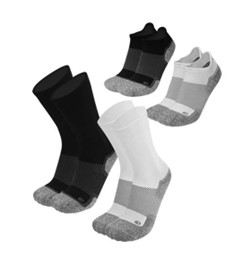Diabetics are among the most susceptible population to have complications with blood circulation in their feet. Diabetic foot care can be practiced to improve circulation in their feet.
Because blood glucose levels are elevated in persons with diabetes, fat deposits can form inside blood vessels. Over time, this causes the narrowing and hardening of the blood vessels, restricting circulation to distant places on the body such as the hands and feet. (This is best referred to as diabetic neuropathy.) Another way persons with diabetes are at increased risk of poor circulation is through damage to the lining of blood vessels, also restricting circulation.
Complications that come with poor circulation include pain upon walking, decreased sensation in hands and feet, slower healing times for wounds in the area, increased risk of ulcers and the need for diabetic foot ulcer treatment, infections and ultimately nerve damage that could result in bodily amputation.
While all of this sounds daunting, there are certain types of diabetic foot care that can be practiced to improve circulation in the feet of those living with diabetes. We’ll walk you through a few life-saving strategies to increase blood flow in compromised areas.
Exercise
The number one way to improve circulation in the diabetic foot is through exercise. Moving muscles in the body causes blood to be pumped to those areas, acting against lesser blood circulation. At least five days a week, aim for aerobic and cardiovascular forms of exercise.
Maintain a balanced, low blood sugar.
As mentioned, people with diabetes have unregulated blood glucose levels, and when elevated; damage to the body occurs. Maintaining a low blood sugar recommended by your doctor through insulin intervention and regular monitoring will further ensure that no damage occurs to your blood vessels, and circulation is able to improve. Keeping level or stable blood sugar also aids in diabetic foot ulcer treatment and prevention, giving the area the ability to heal properly.
Wear Diabetic Socks
Diabetic socks apply regulated pressure to the veins of the feet, as well as keeping them straight and insulated. Not to be confused with compression socks, which can do more harm than good when it comes to diabetic neuropathy: diabetic socks are a form of diabetic foot care that provide an optimal level of compression to encourage circulation.
Avoid smoking
If you suffer from diabetes, one of the worst things you can do is to also be a smoker. On its own, smoking naturally causes blood vessels to narrow. To continue smoking is to further increase the symptoms of diabetes. Cutting out this habit will lessen the chances of blood vessel damage and overall negative effects on the body.
Change your diet
Certain foods encourage healthy blood vessels and blood flow. Incorporating foods high in Omega 3 fatty acids, iron, and fibre all support the health of the heart and overall blood flow throughout the body. Talk with your doctor to discuss a potential diet that can further improve the circulation in your feet.
As mentioned, complications that result from decreased circulation in those with diabetes can be devastating. Proper diabetic foot care and management of this illness will promote healthy circulation throughout your body and elongate your life. Through the practice of exercise, blood sugar maintenance, diabetic socks, and healthier habits you can fight against the natural processes of diabetes, reduce the symptoms and complications of diabetic neuropathy, save compromised blood vessels and avoid the need for diabetic foot ulcer treatment.
When living with diabetes, your body will show signs of dysfunction. It is crucial that you pay attention to any irregularities. Because diabetics are at risk for ulcers, loss of sensation and other forms of pain and injury, constant monitoring and treatment of the foot area is pertinent to the care and regression of the illness. Read more about diabetes here.
Circulation issues most commonly start in the feet! Reach out to Suncoast Podiatry with any of your diabetic foot concerns.

